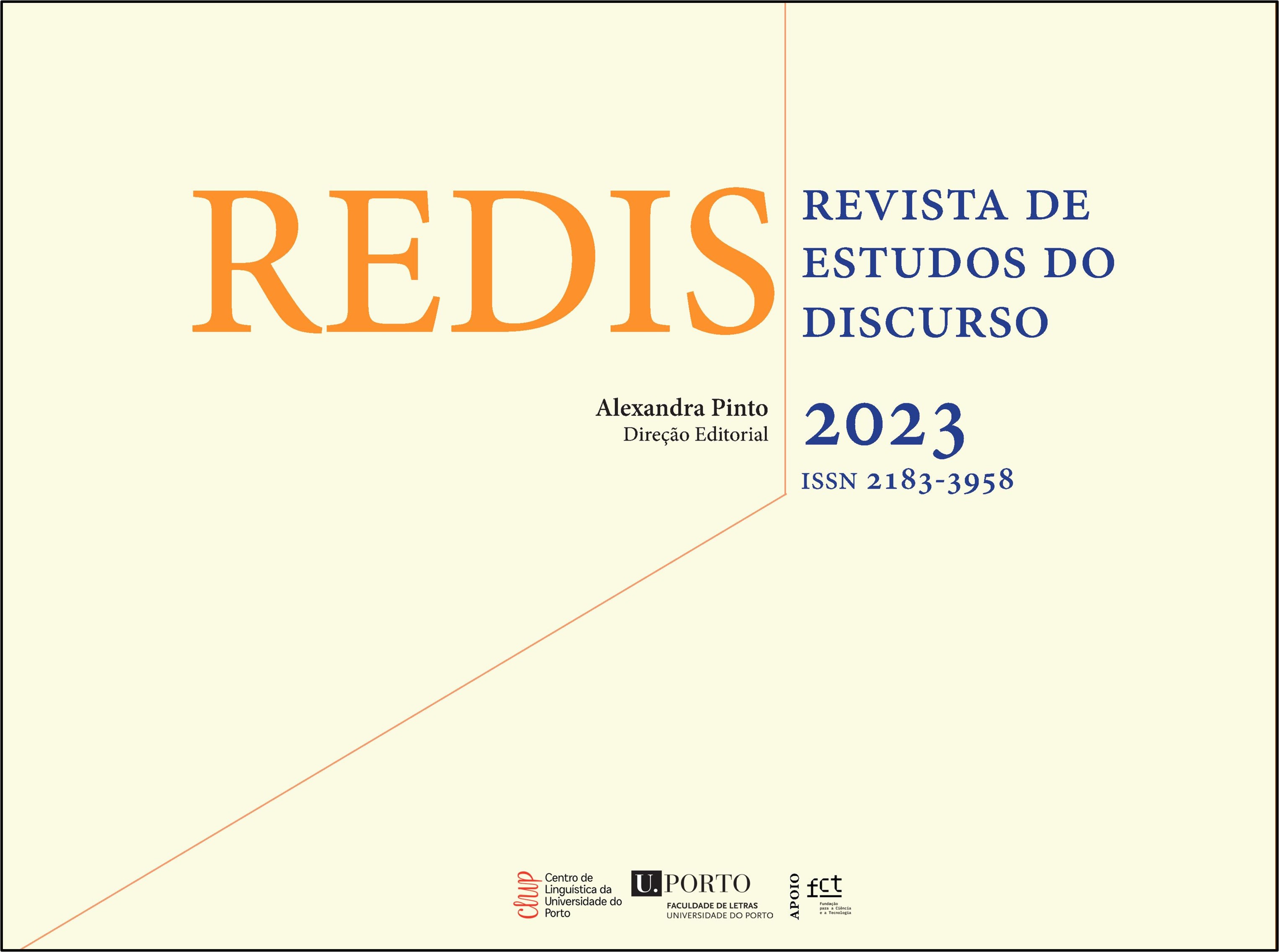Imagens, links e vídeos: argumentação em campanhas eleitorais no Twitter
DOI:
https://doi.org/10.21747/21833958/red13a10Palavras-chave:
Discurso político, Análise do Discurso, Linguística textualResumo
Este artigo traz um pequeno recorte de nossa pesquisa de doutoramento em andamento, a qual busca identificar e analisar aspetos linguísticos e estratégias argumentativas de publicações de campanhas eleitorais em redes sociais dos perfis/páginas oficiais de Jair Bolsonaro e de Fernando Haddad – presidenciais brasileiras de 2018 – e de Ana Gomes e de André Ventura – presidenciais portuguesas de 2021 – com base nos pressupostos teóricos da Análise do Discurso. Apresentamos, aqui, uma análise sobre duas das 15 publicações mais relevantes, de cada candidato, na rede social Twitter, no intervalo temporal de 15 dias imediatamente anteriores ao pleito. Valemo-nos da Linguística Textual, a partir de Adam (1997, 2001a, 2001b), Bronckart (1985) e Plantin (1996), para identificar e analisar como a estrutura da rede social (Bossetta, 2018), enquanto suporte textual, conforme concebido por Maingueneau (2001), influencia a manifestação material dos tecnodiscursos (Paveau, 2021), refletindo na construção das sequências textuais identificadas no corpus, mais especificamente no que toca à forma de apresentação dos argumentos ou dados (premissas) das sequências textuais argumentativas, sendo privilegiadas as composições multimodais com recurso a imagens estáticas, links e vídeos.
Referências
ADAM, J-M. (1985). Quels types de textes? Le Français dans le monde, 192, 39-43.
ADAM, J-M. (1997). Genres, textes, discours: pour une reconception linguistique du concept de genre. In: Revue belge de philologie et d'histoire, tome 75, fasc. 3. Langues et littératures modernes - Moderne taal- en letterkunde, pp. 665-681. https://doi.org/10.3406/rbph.1997.4188.
ADAM, J-M. (2001a). En noir avec les types de textes. In: M. BALLABRIGA, Analyse des discours. Types et genres: Communication et interprétation. Toulouse: EUS, pp. 25-43.
ADAM, J-M. (2001b). Les textes: Types et prototypes. Paris Nathan-Université [1992].
ADAM, J-M. (2005). La notion de typologie de textes en didactique du français: une notion «dépassée»? Recherches, 42, 11-23.
ARISTÓTELES. (2005). Retórica (2nd ed.). Lisboa: Imprensa Nacional – Casa da Moeda. (Col. Obras Completas de Aristóteles).
BAUMANN, G., & GINGRICH, A. (org.) (2004). Grammars of identity/alterity. A structural approach. New York: Bergham Books.
BOSSETTA, M. (2018). The Digital Architectures of Social Media: Comparing Political Campaigning on Facebook, Twitter, Instagram, and Snapchat in the 2016 U.S. Election. Journalism & Mass Communication Quarterly, 95(2), 471–496. https://doi.org/10.1177/1077699018763307.
BRONCKART, J-P. (1985). Le fonctionnement des discours. Un modèle psychologique et une méthode d’analyse. Neuchâtel/Paris: Delachaux & Nestlé.
CHARAUDEAU, P., & MAINGUENEAU, D. (2002). Dictionnaire d’Analyse du Discours. Paris: Armand Colin.
DEVELOTTE, C. (2009). From face to face to distance learning: the online learner’s emerging identity. In GOODFELLOW, R. & LAMY, M. (orgs.). Learning cultures in online education (p. 71-92). London: Continuum Books.
JAKOBSON, R. (2010). Linguística e comunicação (22nd ed.) (Trad. de Izidoro Blikstein & José Paulo Paes). São Paulo: Cultrix.
JEWITT. C. (2011). The Routledge handbook of multimodal analysis. London: Routledge.
KRESS, G. (2010). Multimodality: a social semiotic approach. New York: Routledge.
KRESS, G., & VAN LEEUWEN, T. (2001). Multimodal discourse: the modes and media of contemporary communication. London: Arnold.
MAINGUENEAU, D. (2001). Análise de textos de comunicação. São Paulo: Cortez.
MARCUSCHI, L. A. (2008). Produção textual, análise de gêneros e compreensão. São Paulo: Parábola, 198-225.
MATEUS, S. (2018). Introdução à retórica no Séc. XXI. Covilhã: Editora LabCom.IFP.
MCCRACKEN, G. (1989). Who is the celebrity endorser? cultural foundations of the endorsement process. Journal of Consumer Research, 16, 310-321. https://doi.org/10.1086/209217.
MEYER, M. (2001). Between theory, method, and politics: positioning of the approaches to CDA. In WODAK, R. & MEYER, M. (eds.) Methods of Critical Discourse Analysis. London: Sage, pp. 14-31
PAVEAU, M-A. (2021). Análise do Discurso Digital: dicionário das formas e das práticas. Julia Lourenço Costa; Roberto Leiser Baronas (Orgs.). São Paulo: Pontes Editores.
PINTO, M. A. G. (2015). A retórica do eu e do outro – the Othering. A gramática da identidade no discurso político. In AQUINO, Z. & GONÇALVES-SEGUNDO, P. R. Estudos do discurso: caminhos e tendências. São Paulo: Paulistana, pp. 25-53. Acedido em https://cied.fflch.usp.br/livro-i-cied.
PLANTIN, C. (1996). L’argumentation. Paris, Le Seuil.
SANTOS, S. C., & BICHO, C. P. (2016). Eleições autárquicas 2.0: análise das estratégias de comunicação online de candidatos, partidos e movimentos independentes. Sociologia, problemas e práticas, (81), 189-210. https://doi.org/10.7458/SPP2016813893.
VAN DIJK, T. (2001). Multidisciplinary CDA: a plea for diversity. In Wodak, R. & Meyer, M. (eds.) Methods of Critical Discourse Analysis. London: Sage, pp. 95-120.
WODAK, R. (2001). The discourse historical approach. In Wodak, R. & Meyer, M. (eds.), Methods of Critical Discourse Analysis. London: Sage, pp. 63-94.
WODAK, R.; & MEYER, M. (Eds.) (2001). Methods of critical discourse analysis. London: SAGE Publications.
Downloads
Publicado
Como Citar
Edição
Secção
Licença
Direitos de Autor (c) 2023 Enio Soares

Este trabalho encontra-se publicado com a Licença Internacional Creative Commons Atribuição 4.0.
Os autores cedem à REDIS: Revista de Estudos do Discurso, o direito exclusivo de publicação dos seus textos, sob qualquer meio, incluindo a sua reprodução e venda em suporte papel ou digital, bem como a sua disponibilização em regime de livre acesso em bases de dados.




